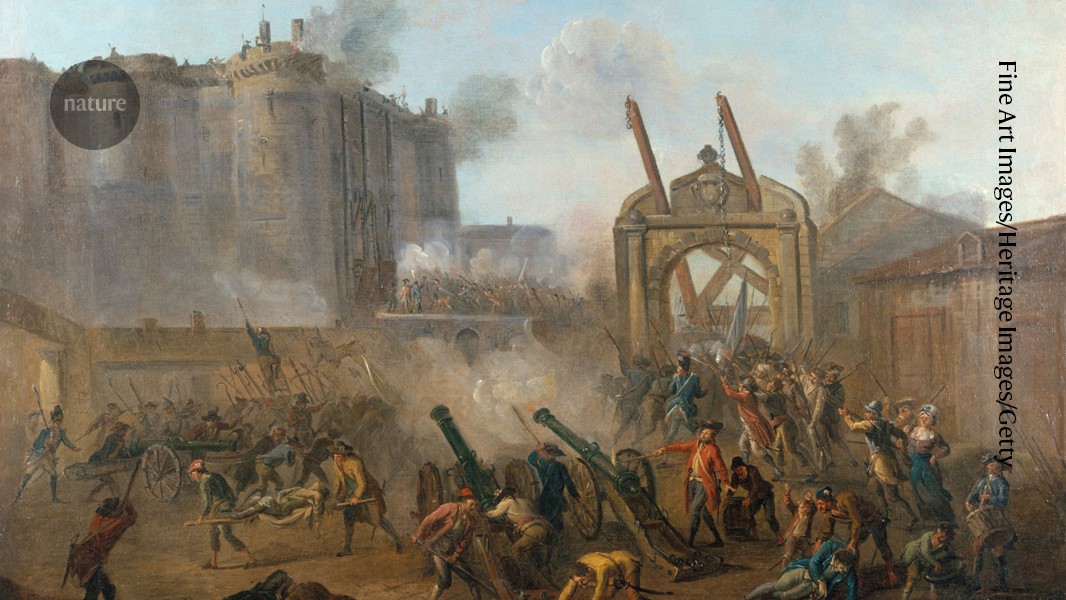An abiding mystery of the French Revolution is solved — by epidemiology

The period of panic and unrest called the Great Fear was triggered by deliberately spread rumours, according to methods borrowed from pandemic playbooks

Revolutionaries in Paris stormed the Bastille as rumours of aristocratic conspiracy swirled in French towns and villages. Credit: Fine Art Images/Heritage Images/Getty
In 1789, rumours spread like a virus across France: gangs of bandits were attacking villages, destroying crops and terrorizing peasants, mobilized by nobles trying to suppress political unrest. None of it was true. But the resulting panic and upheaval, called the Great Fear, helped to fuel the French Revolution — and provoked a debate that still divides historians.
Did a deliberate effort to advance revolution drive the rumours? Or did they emerge spontaneously, driven by genuine terror? Now, scientists have used the methods of epidemiology to solve the mystery. Drawing on historical records and models developed to trace epidemics, researchers conclude that the fearmongering had rational, not emotional, roots1. “We managed to identify the logic behind the dissemination of the Great Fear,” says Antoine Parent, an economist at University Paris 8 and a co-author of the study, published today in Nature.
Using data to objectively measure societal events “is the new paradigm for studying human dynamics”, says Walter Quattrociocchi, a computer scientist specializing in complex systems at Sapienza University of Rome, who has studied the spread of misinformation online. The study focuses on “something that we can measure”, he notes. “So, it’s science. It’s not only speculation.”
Revolutionary rumours
The conspiratorial hearsay that spread across France in July and August of 1789 led peasants to invade castles and destroy land registers, which, in some places, were crucial for the local lord’s claim to authority over estates. The events were among the defining moments of the early days of the French Revolution, a movement that abolished the country’s monarchy, ended feudalism and transformed its political system.
Parent, whose work involves applying complex system analysis to the study of history, met his co-authors, physicist Stefano Zapperi and pathologist Caterina La Porta of the University of Milan, Italy, at a conference. When he shared his plans to investigate the spread of rumours during the Great Fear, La Porta had an idea. “I said, ‘Why don’t we use the techniques that we use to study epidemics?’.”
As the basis of their analysis, the authors relied on a 1932 book by French historian Georges Lefebvre, who compiled letters and other documents indicating how the rumours traveled from one location to the other.
They also used historical road maps to identify the possible dissemination routes. The information allowed the authors to create a detailed map of the stories’ movement from town to town. “We treated it as a transmission network for an epidemic,” Zapperi says.
Then, the team used a mathematical model developed to study the spread of pathogens to analyse how quickly the alarming stories traveled, the routes they followed and which locations were most susceptible to being ‘infected’ by the tall tales.
Going viral
Enjoying our latest content?
Login or create an account to continue
- Access the most recent journalism from Nature's award-winning team
- Explore the latest features & opinion covering groundbreaking research
or
Sign in or create an accountdoi: https://doi.org/10.1038/d41586-025-02739-9
Listen to the related podcast, ‘Viral spread: how rumours surged in revolutionary France’.
This story originally appeared on: Nature - Author:Mariana Lenharo

















